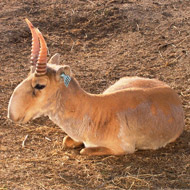‘Sign of hope’ for saiga antelope

Census data shows an increase of saiga numbers in all three populations within Kazakhstan.
Saiga antelope numbers in Kazakhstan have risen following the catastrophic mass die-off event last year.
According to the Ministry of Agriculture of the Republic of Kazakhstan, all three Saiga populations in the country - Ural, Betpak-Dala and Ustyurt - are going up.
Bradnee Chambers, executive secretary of the Convention on Migratory Species, described the news as ‘a sign of hope’, but warns that poaching remains a ‘serious threat’ to the species.
In May 2015, a catastrophic and unprecedented mass die-off caused by a bacterial infection wiped out more than 200,000 saiga antelopes within a few weeks.
The Betpak-Dala saiga population lost almost 90 per cent of its animals - equivalent to over 60 per cent of the global population - leaving the species in a critical situation.
Last week, the Ministry of Agriculture of the Republic of Kazakhstan published the results of an aerial census, which was conducted in April 2016.
The census data shows an increase of saiga numbers in all three populations within Kazakhstan, the antelope’s main Range State.
“The news about recovering saiga populations in Kazakhstan is a sign of hope after the catastrophic mass saiga die-off event in 2015," said Bradnee Chambers.
“At the same time, poaching remains a serious threat to the species and we need to be aware of the fact that mass die-offs such as the one which shocked the world in 2015 can occur again and that we have still not fully understood the underlying causes of the mass die-off.”



 The Animal and Plant Health Agency (APHA) has updated its online reporting service for dead wild birds.
The Animal and Plant Health Agency (APHA) has updated its online reporting service for dead wild birds.